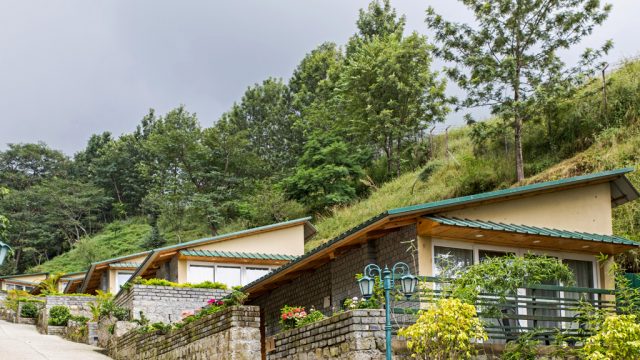The winding path down to the monastery was hemmed with tall pines, glowing orange in a slow-motion sunset. Women carrying firewood strapped to their backs crossed our path and greeted us with namastes. The shepherdesses followed their goats who were leisurely chomping on grass as they made their way back to the village.

Nestled between the steep granite peaks of the Dhauladhars and the sweeping Kangra Valley in Himachal Pradesh, Rakkh is one of those fast-becoming-scarce places almost untouched by the tenacious forces of commercialization. Barely inhabited by five hundred or so families, the houses are still built of mud, wood and slate barring a few concrete monstrosities. But it is a village, nonetheless. Women still prepare their meals on firewood and you will cross a cowshed after every two houses. Almost everyone has a vegetable patch outside their house.


At the monastery, a nun hurriedly fingered her prayer beads as she walked in circles around the blooming garden while an old monk bestowed upon us the warmest smile I’d seen in a long time. It was already dark by the time we left and I mistook the luminous, creamy orange ball behind the pine trees for a street-lamp. It was actually the moon. I don’t remember seeing it that big ever.

As we dragged our weary public transport accustomed bodies back to the comforts of Rakkh Resort, a huge bonfire awaited us outside the resort’s traditional Himachali open kitchen. Even though the menu offers a variety of cuisines, the resort focuses on promoting local flavors by preparing for its guests the traditional dhaam (feast) cooked on a wood-fired chulha by a sweet lady from the village. We gorged on khatta maas (mutton slow-cooked in a tangy gravy), saag with jaggery, and a kadhi made with thinned-buttermilk and chapattis.

With fifteen cottages, a spa and a multi-cuisine restaurant spread over an entire slope of a hill overlooking the vast expanse of the Kangra Valley on its south and snow-clad peaks on its north, the resort offers all the amenities one can expect in a location as remote as this without going over-board. The bathrooms have all the latest fittings and the bed is fit for a king but there is no room-service, no internet and no television.The cottages are constructed from locally-sourced materials. There are shampoo and soap dispensers in the bathrooms instead of the tiny plastic bottles that we are used to. Even the drinking water in the room is stored in glass bottles. And to top it all, one side of the room is made of sliding glass doors. Waking up to a view like that with mountains staring at back at me with eagles and swallows flying around their peaks is the greatest luxury I could ever ask for.

Cottages at Rakkh Resort
On my second day in Rakkh, our guide Sam took us on a hike up to the Sidh Baba Mandir, a little shrine perched on top of a hill adjacent to the resort. On the way we dipped our feet in the cold, clear water of a gurgling stream. We got lost in the sheer variety of wildflowers growing all around us. We lay down in a meadow, smoked cigarettes and collected pine cones till we finally reached the top of the hill. There we saw a lone two-storey house standing beside the temple. Built in the traditional Kangra-style, the 300-year old house is inhabited by a family who has been living there for the last nine generations. They invited us in for tea. We sat with the grandmother and listened to her reminisce about the years gone by as the great mountains pocketed the sun.

A stream on the way up to Side Baba Mandir
The information
Getting There
Rakkh is easily accessible by air from the Kangra-Gaggal Airport which is less than an hour’s drive away. There are generally two daily flights from Delhi and onward connecting flights nationwide. The nearest railheads at Pathankot and Una are a 3 hour drive.
Location
Ghamrota Village, P. O. Ballah, Tehsil Palampur, District Kangra, Himachal Pradesh, India- 176061
Contact
+ 91-8800409567, info@rakkh.com
Things to Do
The resort organizes visits to nearby Bajinath Temple, Andretta Pottery, Dharamsala and McLeod Ganj. All can be done in a day since they are located nearby. It also offers pottery and weaving workshops along with guided mountain biking, hiking trails, wall climbing, slack-lining and camp skills workshops for children.




